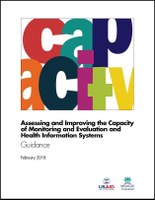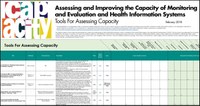Assessing the Capacity of Monitoring and Evaluation and Health Information Systems
The assessment of capacity is an important step in identifying, describing, and documenting evidence related to the stages of progression to a strong health information system (HIS), and is a particularly effective way to measure and document those stages. The information can be used to expand our knowledge of capacity building (CB) for HIS and for monitoring and evaluation (M&E) systems, thereby informing the design of new interventions and the adaptation of existing approaches. The assessment of capacity is also an essential approach to designing technical assistance, training, mentoring, or related interventions to strengthen health systems; to building M&E‐related capacity at individual, organizational, or systems levels; and ultimately, to improving health outcomes (Horton, 2003).
Much of what is written about capacity assessment and planning is fragmented and geared to the use of a specific assessment method or tool. This guidance takes a broader view of capacity assessment, providing practical considerations for choosing a specific CB approach. The guidance also provides suggestions for the use of assessment results, including the development of a CB plan (CBP).
This guidance is intended for use by those working with individuals, teams, organizations, or systems to improve capacity in M&E or HIS. This capacity building work may be explicit (for example, in response to a formal request from the beneficiary or donor) or it may be implicit (as in the case of collaborative implementation of an evaluation).
The guidance and its associated tools focus on the assessment of the capacity of teams, organizations, and systems, with individual capacity included, as well.














